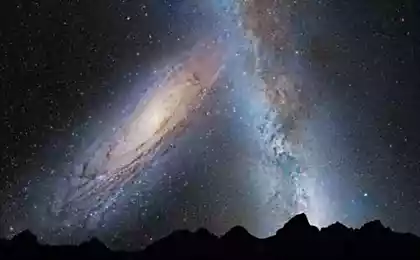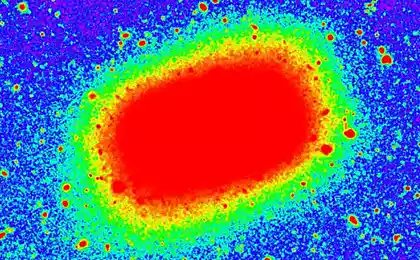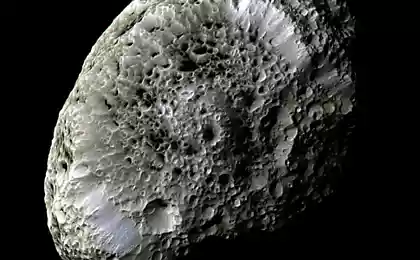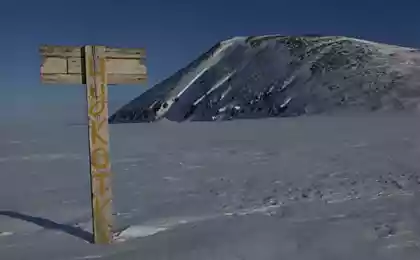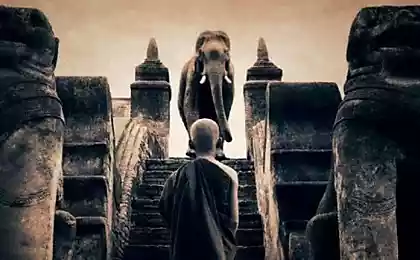973
Getting to know our galaxy.
Milky Way
We begin not with the fact, and to explore our galaxy. Tonight, when the sun disappears behind the horizon, look up. Depending on how it will be dark, you can see a cluster of stars, each of which relates to our own Milky Way galaxy. But if you look closely closely, you will be able to identify the stars and other galaxies other than our own, some of which are visible to the naked eye.

Other Galaxy
This fact will certainly make you feel small. Scientists estimate that there are hundreds of billions of galaxies in the universe, none of which you will not see without a telescope. In addition each of these galaxies have billions of stars, and the total number of stars in the universe leads to a 10 billion trillion. Stars more than the number of grains of sand on all the beaches of the Earth.

Dark Matter
All the stars, galaxies and black holes in the universe only make up about 5% of its mass. As crazy as it may sound, the remaining 95% is simply not taken into account. Scientists decided to label this mysterious dark matter material, and to this day they are still not sure what it is and how it looks.

The cosmic cloud of alcohol
For those who want to open their own bar, there is no place better than the cloud Sagittarius B (Sagittarius B). Although it is located in the region of 26, 000 light years, it interstellar gas and dust cloud contains billions of gallons of vinyl alcohol. Although he is in a state not suitable for drinking, it is very important organic compound, which is essential to the existence of life

The moon smells like gunpowder
After sending astronauts to the lunar Apollo missions, lunar dust they described as very soft and smelled gunpowder. Scientists, however, are still not exactly sure why this is happening. In powder compositions very different from lunar dust, consisting mostly of small particles of silicon dioxide glass.

A nuclear strike on the moon
In the late 1950s he was born something that marked project A119. The United States decided that it would be a good idea - to launch a nuclear missile, hitting the moon. What for? Obviously, they felt that it would give them a head start in the space race? Fortunately, this plan was never implemented.

Ponzo illusion
Have you ever noticed that when the moon is right on the horizon, it seems much closer and more? In fact, it is a feature of the human brain to interpret the objects at a distance. Although subjects in the distance really small, in fact, your brain does not interpret them as tiny. The effect is known as the Ponzo illusion, when the brain inflates the size of the moon, to make it appear larger. Do not believe? The next time ogronuyu see the moon, put it on the background of his watch or his hand and see how it decreases

The largest diamond
In 2004, scientists discovered the largest diamond ever recorded. In fact, it is - the destruction of the star. Is about 4,000 kilometers in diameter, with billions of carats, it is located at a distance of about 50 light years from Earth.

Venus day longer than its year
Oddly, Venus passes all its orbit around the sun before it manages to turn around its own axis. This means that the day is actually more durable than a year by the time of Venus. Thus, the Second World War on a scale of Venus over less than 100 days ago.

Floating Saturn
If you need to put Saturn in a glass of water, he would have sailed. The reason for this lies in its density. 687 grams per cm cubed, while the water is 998 grams per cubic cm. Unfortunately, you would need in a glass, which is more than 120, 000 km in diameter, to witness it.
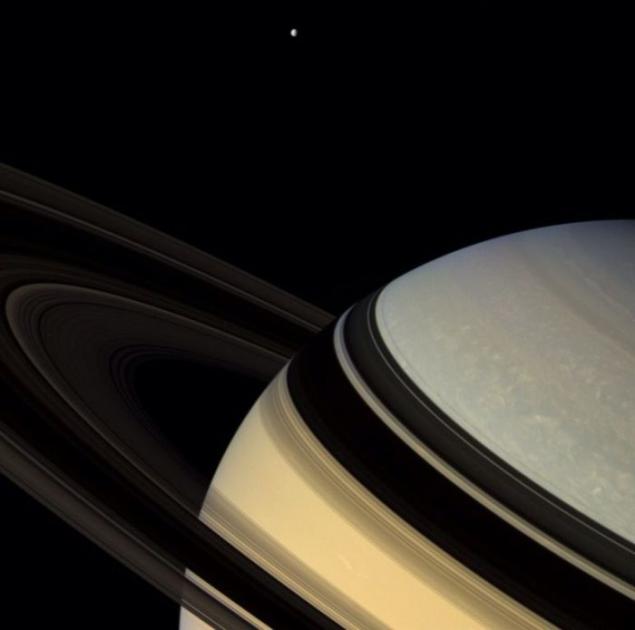
Cold welding
This is - the phenomenon used to describe the fact that whenever two pieces of metal into the space in contact with each other, they stick together very tightly. While welding usually requires a high temperature, in which case the vacuum of space plays a role. The question arises as space shuttles resist this factor? Typically, the metal in the world there is a layer of oxidized material covering their surface that prevents cold welding in space. Thus, the risk of accidental missions welding shuttle with other objects is negligible.

The Earth has few moons
Though they are more like lunar imitators, but scientists have discovered several asteroids that are more or less follow the Earth while it moves around the sun.

Space debris
The Earth does have more than 8, 000 objects orbiting in an orbit. Most of them are classified as "space junk" or debris from the spacecraft and missions in the past. Already we mentioned that the Earth's orbit can be considered the most polluted places on Earth.

Lunar drift
Scientists have calculated that every year the moon moves 3.8 cm further away from the Earth. As a result, the Earth's rotation slowed down by approximately .002 of a second every day for the last century.

Sunlight on Earth 30,000 years
Most of us know that your journey to earth the sun's rays is doing for 8 minutes, crossing the 93 million miles between Earth and the Sun's surface. But did you know that the energy of these rays began life more than 30, 000 years ago, deep in the core of the sun? They were formed by intense fusion reactions and spent most of the thousands of years, making their way to the surface of the sun.

Big Dipper - is not a constellation
In fact, the Big Dipper - this asterism. There are only 88 official constellations, and all the others, including the bucket - fall into the category asterisms. However, it consists of 7 constellation's brightest stars Big Ursa, or Big Dipper

The spatial relativity of Galileo
How do you know that the bus that you get to work, actually moved? What if you are sitting in the only stationary object in the known universe, and everything else, including the road moves? The truth is that there is no way to prove that is moved relative to what. For you, the man behind the window will be static, because your belief system - bus. For the person looking from the sidewalk, however, and you, and the bus will move, because his belief system - the earth.

Speed of Light
The speed of light is constant and independent of any confounding factors. The speed of light is about 300,000 kilometers per second.

We begin not with the fact, and to explore our galaxy. Tonight, when the sun disappears behind the horizon, look up. Depending on how it will be dark, you can see a cluster of stars, each of which relates to our own Milky Way galaxy. But if you look closely closely, you will be able to identify the stars and other galaxies other than our own, some of which are visible to the naked eye.

Other Galaxy
This fact will certainly make you feel small. Scientists estimate that there are hundreds of billions of galaxies in the universe, none of which you will not see without a telescope. In addition each of these galaxies have billions of stars, and the total number of stars in the universe leads to a 10 billion trillion. Stars more than the number of grains of sand on all the beaches of the Earth.

Dark Matter
All the stars, galaxies and black holes in the universe only make up about 5% of its mass. As crazy as it may sound, the remaining 95% is simply not taken into account. Scientists decided to label this mysterious dark matter material, and to this day they are still not sure what it is and how it looks.

The cosmic cloud of alcohol
For those who want to open their own bar, there is no place better than the cloud Sagittarius B (Sagittarius B). Although it is located in the region of 26, 000 light years, it interstellar gas and dust cloud contains billions of gallons of vinyl alcohol. Although he is in a state not suitable for drinking, it is very important organic compound, which is essential to the existence of life

The moon smells like gunpowder
After sending astronauts to the lunar Apollo missions, lunar dust they described as very soft and smelled gunpowder. Scientists, however, are still not exactly sure why this is happening. In powder compositions very different from lunar dust, consisting mostly of small particles of silicon dioxide glass.

A nuclear strike on the moon
In the late 1950s he was born something that marked project A119. The United States decided that it would be a good idea - to launch a nuclear missile, hitting the moon. What for? Obviously, they felt that it would give them a head start in the space race? Fortunately, this plan was never implemented.

Ponzo illusion
Have you ever noticed that when the moon is right on the horizon, it seems much closer and more? In fact, it is a feature of the human brain to interpret the objects at a distance. Although subjects in the distance really small, in fact, your brain does not interpret them as tiny. The effect is known as the Ponzo illusion, when the brain inflates the size of the moon, to make it appear larger. Do not believe? The next time ogronuyu see the moon, put it on the background of his watch or his hand and see how it decreases

The largest diamond
In 2004, scientists discovered the largest diamond ever recorded. In fact, it is - the destruction of the star. Is about 4,000 kilometers in diameter, with billions of carats, it is located at a distance of about 50 light years from Earth.

Venus day longer than its year
Oddly, Venus passes all its orbit around the sun before it manages to turn around its own axis. This means that the day is actually more durable than a year by the time of Venus. Thus, the Second World War on a scale of Venus over less than 100 days ago.

Floating Saturn
If you need to put Saturn in a glass of water, he would have sailed. The reason for this lies in its density. 687 grams per cm cubed, while the water is 998 grams per cubic cm. Unfortunately, you would need in a glass, which is more than 120, 000 km in diameter, to witness it.

Cold welding
This is - the phenomenon used to describe the fact that whenever two pieces of metal into the space in contact with each other, they stick together very tightly. While welding usually requires a high temperature, in which case the vacuum of space plays a role. The question arises as space shuttles resist this factor? Typically, the metal in the world there is a layer of oxidized material covering their surface that prevents cold welding in space. Thus, the risk of accidental missions welding shuttle with other objects is negligible.

The Earth has few moons
Though they are more like lunar imitators, but scientists have discovered several asteroids that are more or less follow the Earth while it moves around the sun.

Space debris
The Earth does have more than 8, 000 objects orbiting in an orbit. Most of them are classified as "space junk" or debris from the spacecraft and missions in the past. Already we mentioned that the Earth's orbit can be considered the most polluted places on Earth.

Lunar drift
Scientists have calculated that every year the moon moves 3.8 cm further away from the Earth. As a result, the Earth's rotation slowed down by approximately .002 of a second every day for the last century.

Sunlight on Earth 30,000 years
Most of us know that your journey to earth the sun's rays is doing for 8 minutes, crossing the 93 million miles between Earth and the Sun's surface. But did you know that the energy of these rays began life more than 30, 000 years ago, deep in the core of the sun? They were formed by intense fusion reactions and spent most of the thousands of years, making their way to the surface of the sun.

Big Dipper - is not a constellation
In fact, the Big Dipper - this asterism. There are only 88 official constellations, and all the others, including the bucket - fall into the category asterisms. However, it consists of 7 constellation's brightest stars Big Ursa, or Big Dipper

The spatial relativity of Galileo
How do you know that the bus that you get to work, actually moved? What if you are sitting in the only stationary object in the known universe, and everything else, including the road moves? The truth is that there is no way to prove that is moved relative to what. For you, the man behind the window will be static, because your belief system - bus. For the person looking from the sidewalk, however, and you, and the bus will move, because his belief system - the earth.

Speed of Light
The speed of light is constant and independent of any confounding factors. The speed of light is about 300,000 kilometers per second.









